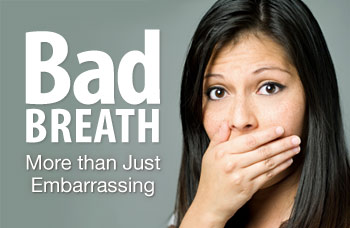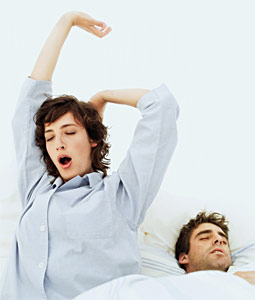Bad Breath
More than Just Embarrassing

Halitosis, a.k.a. oral malodor, fetor oris, foul breath, or just plain old bad breath are terms used to describe noticeably unpleasant odors exhaled in breathing. From the Latin halitus (exhalation) and the Greek osis (a condition or disease-causing process), the term denotes unpleasant smelling breath that arises from both physiological (normal body), and pathological (disease-causing) states that may be either from the mouth, the body or both. Bad breath has a significant impact both personally and socially on those who suffer from it, as well as those on the receiving end. There's even a term for people who believe or fear they have bad breath “halitophobia.”
Each year, Americans are estimated to spend their money to the tune of nearly $3 billion a year on fresh breath remedies, including gum, mints and mouth rinses.
Many studies place bad breath as the third most frequent reason for seeking dental treatment following tooth decay and gum disease. Each year, Americans are estimated to spend their money to the tune of nearly $3 billion a year on fresh breath remedies, including gum, mints and mouth rinses. These purchases are due in part to aggressive advertising by mouthwash and toothpaste manufacturers for their products that promise to make your breath sweet and attractive, especially to the opposite sex. Time magazine even referred to Listerine's PocketPaks®, the first breath strips that dissolved on the tongue, as one of their “Products of the Year” when they debuted in 2001, underscoring the impact and importance of halitosis, bad breath, to the public.
Prevalence
For over 2,000 years, at least since Hippocrates suggested the use of a rinse made from herbs and wine for sweetening bad breath, halitosis has long been recognized as a common unpleasant part of the human condition. Researchers estimate the prevalence of unacceptable bad breath in about 50% of middle-aged and older adults — not to mention smokers' breath in the 20-25% of the U.S. population who smoke. Furthermore, a U.S. phone survey recently found 60% of women and 50% of men say they use cosmetic breath freshening products like candies, chewing gum and sprays. Bad breath is clearly a major concern of adults.
 |
| Because the mouth is dry and inactive during the night, the odor is usually worse upon awakening. This normal halitosis — “morning breath” — is universal in adults. |
In 85-90% of all cases, bad breath originates in the mouth itself. Because the mouth is dry and inactive during the night, the odor is usually worse upon awakening. This normal halitosis — “morning breath” — is universal in adults. The intensity of bad breath differs during the day as a function of oral dryness due to stress, fasting or eating certain foods (garlic, onions, meat, fish and cheese, the most likely culprits), along with smoking and alcohol consumption. Bad breath may be transient, often disappearing after eating, brushing one's teeth, flossing, or rinsing with mouthwash.
Bad breath may also be persistent or chronic, which is a more serious condition, affecting some 25% of the population to varying degrees. It can negatively impact the individual's personal, social and business relationships, leading to poor self-esteem and increased stress. This condition is usually caused by the activity of certain types of oral bacteria.



